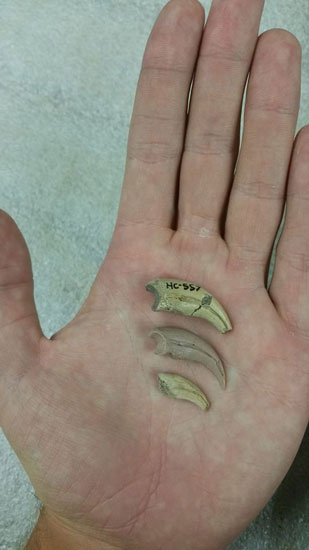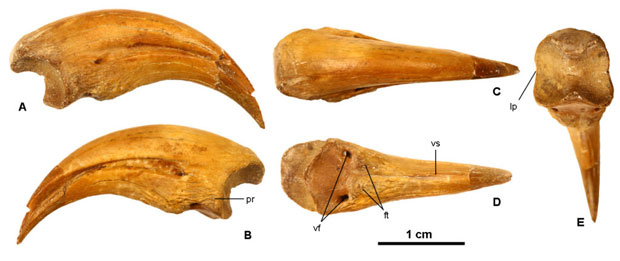“Captain Hook” A New Dinosaur from Hell Creek
Trierarchuncus prairiensis – The Last Alvarezsaurid
A new species of alvarezsaurid dinosaur has been described from fragmentary remains consisting of a foot bone, a partial radius (arm bone) and three thumb claws which might represent a progressive size series. The little dinosaur has been named Trierarchuncus prairiensis and the fossils come from the uppermost Maastrichtian Hell Creek Formation of Montana and demonstrate that these bizarre, little theropods survived until the very end of the Cretaceous.
A Life Reconstruction of the Newly Described Alvarezsaurid T. prairiensis
Picture credit: Badlands Dinosaur Museum (North Dakota) model created by Boban Filipovic
The Most Complete Alvarezsaurid Claw Described to Date
Writing in the journal “Cretaceous Research”, the research team that includes lead author Dr Denver Fowler (Badlands Dinosaur Museum), describe the three thumb claws (manual digit 1) which are of different sizes. They conclude that these three claws probably represent a growth series and from this they can plot how the claw changed as the alvarezsaurid grew. As Trierarchuncus matured, the thumb claw became more robust and roughened.
Blood vessel grooves on the manual ungual (claw) became more deeply embedded in the bone. One claw, the middle-sized specimen, represents the most complete alvarezsaurid thumb claw described to date and it demonstrates that these claws were more curved than previously thought. A powerful, strongly curved thumb claw would have helped this small dinosaur to rip into rotten wood in search of invertebrates. It has also been suggested that alvarezsaurids evolved to exploit termites as a food source, that is, they exhibited termitophagy (specialised consumers of termites). The single claw on each hand in association with strong forelimbs could have been used to tear apart termite nests.
A View of the Three Alvarezsaurid Fossil Claws (Proposed Ontogenetic Series)

Picture credit: Badlands Dinosaur Museum (North Dakota)
Inspired by Captain Hook!
The claws were the inspiration behind the dinosaur’s name. The genus name comes from the Greek “trierarch”, a reference to the appointed officers responsible for a Greek warship, whilst “uncus” is the Latin for hook. The trivial or species name honours the gentle, rolling prairies of eastern Montana where the fossils were found. The name which is pronounced Try-er-arch-unk-cus pray-ree-en-sis translates as “Captain Hook of the prairies”. This is also a nod in the direction of the infamous “Captain Hook”, a fictional character, the nemesis of Peter Pan created by J. M. Barrie.
The Three Thumb Claws from the Alvarezsaurid in the Study

Picture credit: Badlands Dinosaur Museum (North Dakota)
Implications for the Taxonomy and Phylogeny of the Alvarezsauroidea
If the three claw specimens do indeed represent a growth series (an ontogenetic series), then this discovery could have far-reaching consequences for all those maniraptoran dinosaurs confined within the Alvarezsauroidea. If the claws of these dinosaurs changed radically as the animal grew and matured, then supposedly unique features (autapomorphies), used to erect other alvarezsaurid genera might be unreliable. These features might be attributed to the relatively young age of the dinosaur when it died, rather than representing a defining anatomical characteristic that can lead to the naming of a new species.
Views of the Thumb Claw Showing Curvature (MOR 6622 – Holotype Claw)
Picture credit: Badlands Dinosaur Museum (North Dakota)
The Youngest Known Alvarezsaurid
Stratigraphic data indicates that Trierarchuncus represents the youngest known alvarezsaurid. Fossils associated with these types of theropod occur through most of the eighty-five metre thick Hell Creek Formation, with the uppermost specimen having been found within a few metres of the contact with the Palaeocene-aged Fort Union Formation. It is likely that alvarezsaurids were present in North America throughout the Late Cretaceous and that they persisted until the extinction of the non-avian dinosaurs.
Evidence suggests that alvarezsaurids originated in Asia: Haplocheirus – Is it a bird? No, it is a dinosaur.
Did alvarezsaurids eat eggs? An article from 2018: Did Alvarezsaurids eat eggs?
The scientific paper: “Trierarchuncus prairiensis gen. et sp. nov., the last alvarezsaurid: Hell Creek Formation (uppermost Maastrichtian), Montana” by Denver W. Fowler, John P. Wilson, Elizabeth A. Freedman Fowler, Christopher R. Noto, Daniel Anduza and John R. Horner published in Cretaceous Research.
Visit the Everything Dinosaur website: Everything Dinosaur.



